
Neuschwanstein Castle is a 19th-century historicist palace on a rugged hill of the foothills of the Alps in the very south of Germany. It is located in the Swabia region of Bavaria, in the municipality of Schwangau, above the incorporated village of Hohenschwangau, which is also the location of Hohenschwangau Castle. The closest larger town is Füssen. The castle stands above the narrow gorge of the Pöllat stream, east of the Alpsee and Schwansee lakes, close to the mouth of the Lech into Forggensee.

A great hall is the main room of a royal palace, castle or a large manor house or hall house in the Middle Ages. It continued to be built in the country houses of the 16th and early 17th centuries, although by then the family used the great chamber for eating and relaxing. At that time the word "great" simply meant big and had not acquired its modern connotations of excellence. In the medieval period, the room would simply have been referred to as the "hall" unless the building also had a secondary hall. The term "great hall" has been mainly used for surviving rooms of this type for several centuries to distinguish them from the different type of hall found in post-medieval houses. Great halls were found especially in France, England and Scotland, but similar rooms were also found in some other European countries.

Jever is the capital of the district of Friesland in Lower Saxony, Germany. The name Jever is usually associated with a major brand of beer, Jever Pilsener, which is produced there. The city is also a popular holiday resort. Jever was granted city status in 1536. Unofficially Jever is sometimes referred to as Marienstadt in reference to Maria of Jever, the last independent ruler of the city. The inhabitants of Jever are named Jeveraner ("Jeverans").

Nassau Castle, located in Nassau, Rhineland-Palatinate, Germany, was the original seat of the House of Nassau. The ruins of the castle are situated on a rock outcropping about 120 m (390 ft) above the Lahn River. The House of Nassau was an aristocratic dynasty among whose descendants are the present-day monarchy of the Netherlands and Luxembourg.

An L-plan castle is a castle or tower house in the shape of an L, typically built from the 13th to the 17th century. This design is found quite frequently in Scotland, but is also seen in England, Ireland, Romania, Sardinia, and other locations. The evolution of its design was an expansion of the blockhouse or simple square tower from the Early Middle Ages. As building techniques improved, it became possible to construct a larger building footprint and a more complex shape than the simple blockhouse tower. A more compelling motivation for the L plan was the ability to defend the entrance door by providing covering fire from the adjacent walls. This stratagem was particularly driven by the advent of cannon used by attackers.

Poggibonsi is a town in the province of Siena, Tuscany, Central Italy. It is located on the River Elsa and is the main centre of the Valdelsa Valley.
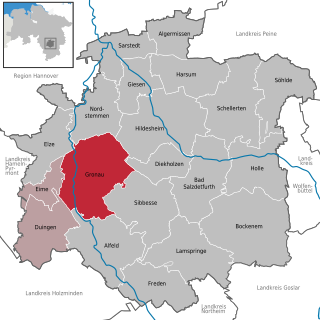
Gronau is a town and a municipality in the district of Hildesheim, in Lower Saxony, Germany. It is situated on the River Leine, approximately 15 km southwest of Hildesheim, and 35 km south of Hanover. Since 1 November 2016, the former municipalities Banteln, Betheln, Brüggen, Despetal and Rheden are part of the municipality Gronau.

Nörten-Hardenberg is a municipality in the district of Northeim, in Lower Saxony, Germany.

Romanesque architecture is an architectural style of medieval Europe characterised by semi-circular arches. The term "Romanesque" is usually used for the period from the 10th to the 12th century with "Pre-Romanesque" and "First Romanesque" being applied to earlier buildings with Romanesque characteristics. Romanesque architecture can be found across the continent, diversified by regional materials and characteristics, but with an overall consistency that makes it the first pan-European architectural style since Imperial Roman Architecture. The Romanesque style in England is traditionally referred to as Norman architecture.
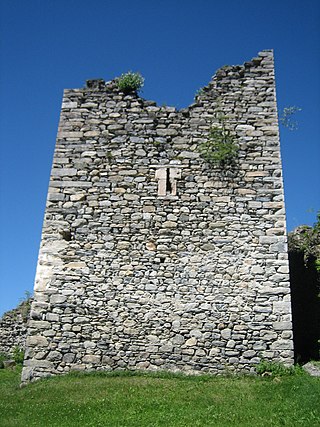
Castels Castle is a castle in the municipality of Luzein of the Canton of Graubünden in Switzerland. It is a Swiss heritage site of national significance.

The Wolfsburg is a medieval lowland and water castle in North Germany that was first mentioned in the records in 1302, but has since been turned into a Renaissance schloss or palace. It is located in eastern Lower Saxony in the town of Wolfsburg named after it and in whose possession it has been since 1961. The Wolfsburg developed from a tower house on the River Aller into a water castle with the character of a fortification. In the 17th century it was turned into a representative, but nevertheless defensible palace that was the northernmost example of the Weser Renaissance style. Its founder and builder was the noble family of von Bartensleben. After their line died out in 1742 the Wolfsburg was inherited by the counts of Schulenburg.

Stein Castle is a Saxon castle located southeast of Zwickau in the village of Stein in the municipality of Hartenstein on the rocky banks of the Zwickauer Mulde in the east German state of Saxony.

Windeck Castle, also Old Windeck Castle, is a ruined Black Forest spur castle which stands on a 378-metre-high spur in the Bühl district of Kappelwindeck, in the county of Rastatt in the German state of Baden-Württemberg.

The ruins of the former Splügen Castle lie east of the village of Splügen in the Rheinwald forest in the Swiss canton of Graubünden. It is the only castle in the valley.

Otzberg Castle in the German state of Hesse is a medieval castle on the summit of the Otzberg in the Odenwald forest at a height of 367 m above NN. On its northern slopes is the village of Hering, which grew out of the lower ward or castellan's settlement. The history of castle and village is therefore closely interwoven.

Wellheim Castle is a former fortification in Upper Bavaria. The ruins of the old rock castle stand dominantly on Jurassic rocks above the market town of Wellheim in the ancient Danube valley. It was abandoned in the 18th century and partially demolished.

Hardeg Castle is an old castle in the little Lower Saxon town of Hardegsen in the German county of Northeim. It was built in the 12th century and used to be the seat of government of the Welf dukes.
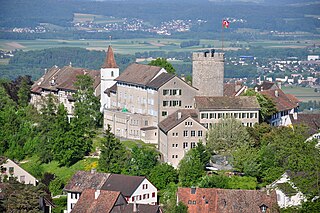
Regensberg Castle is a hill castle which was built about the mid-13th century AD by the House of Regensberg in the Swiss municipality of Regensberg in the Canton of Zürich.
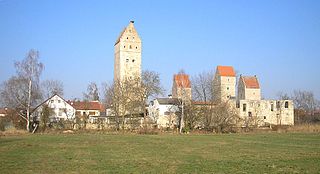
Nassenfels Castle stands at the edge of the market village of Nassenfels in the county of Eichstätt in Upper Bavaria. The former water castle is still lived in and may only be viewed from the outside.
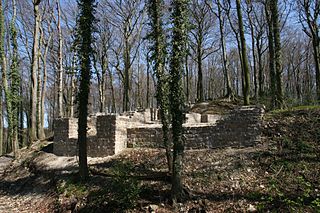
The Holter Burg is the oldest castle site in the municipality of Bissendorf near Osnabrück in the German state of Lower Saxony. It is the ruin of a hill castle. It was the third hill castle in Osnabrück Land along with the Iburg and the Wittekindsburg near Rulle.
























